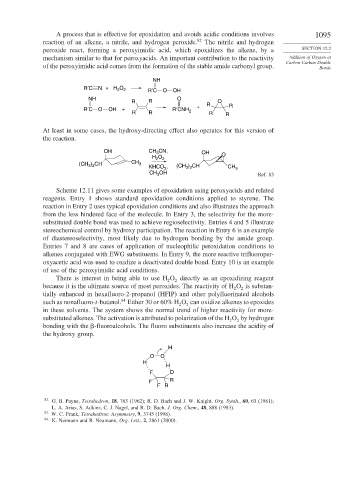Page 1119 - Advanced Organic Chemistry Part B - Reactions & Synthesis
P. 1119
A process that is effective for epoxidation and avoids acidic conditions involves 1095
reaction of an alkene, a nitrile, and hydrogen peroxide. 82 The nitrile and hydrogen
peroxide react, forming a peroxyimidic acid, which epoxidizes the alkene, by a SECTION 12.2
mechanism similar to that for peroxyacids. An important contribution to the reactivity Addition of Oxygen at
Carbon-Carbon Double
of the peroxyimidic acid comes from the formation of the stable amide carbonyl group. Bonds
NH
R′C N +H O 2 R′C O OH
2
NH O
R R O
+ R R
R′C O OH + R′CNH 2
R R R R
At least in some cases, the hydroxy-directing effect also operates for this version of
the reaction.
OH CH CN, OH
3
H O 2 O
2
) CH CH 3
(CH 3 2 ) CH
KHCO , (CH 3 2 CH 3
3
CH OH Ref. 83
3
Scheme 12.11 gives some examples of epoxidation using peroxyacids and related
reagents. Entry 1 shows standard epoxidation conditions applied to styrene. The
reaction in Entry 2 uses typical epoxidation conditions and also illustrates the approach
from the less hindered face of the molecule. In Entry 3, the selectivity for the more-
substituted double bond was used to achieve regioselectivity. Entries 4 and 5 illustrate
stereochemical control by hydroxy participation. The reaction in Entry 6 is an example
of diastereoselectivity, most likely due to hydrogen bonding by the amide group.
Entries 7 and 8 are cases of application of nucleophilic peroxidation conditions to
alkenes conjugated with EWG substituents. In Entry 9, the more reactive trifluoroper-
oxyacetic acid was used to oxidize a deactivated double bond. Entry 10 is an example
of use of the peroxyimidic acid conditions.
There is interest in being able to use H O directly as an epoxidizing reagent
2 2
because it is the ultimate source of most peroxides. The reactivity of H O is substan-
2 2
tially enhanced in hexafluoro-2-propanol (HFIP) and other polyfluorinated alcohols
84
such as nonafluoro-t-butanol. Either 30 or 60% H O can oxidize alkenes to epoxides
2 2
in these solvents. The system shows the normal trend of higher reactivity for more-
substituted alkenes. The activation is attributed to polarization of the H O by hydrogen
2
2
bonding with the
-fluoroalcohols. The fluoro substituents also increase the acidity of
the hydroxy group.
H
O O
H
H
F O
F R
F R
82
G. B. Payne, Tetrahedron, 18, 763 (1962); R. D. Bach and J. W. Knight, Org. Synth., 60, 63 (1981);
L. A. Arias, S. Adkins, C. J. Nagel, and R. D. Bach, J. Org. Chem., 48, 888 (1983).
83 W. C. Frank, Tetrahedron: Asymmetry, 9, 3745 (1998).
84
K. Neimann and R. Neumann, Org. Lett., 2, 2861 (2000).

